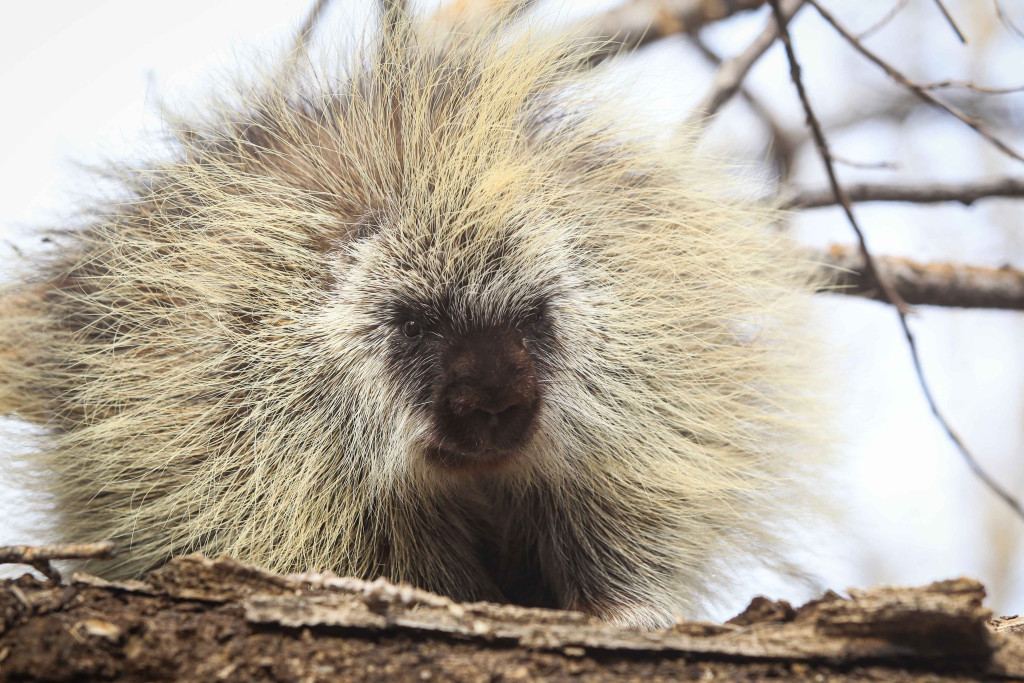
By Monica Macoubrie, Wildlife Education Specialist
Sometimes, our fascination with wildlife can lead to the perpetuation of myths and misconceptions. From fabled tales that have been passed down through the generations to more quirky beliefs that find their way into modern folklore, animal myths captivate our imagination and influence the way we perceive and interact with the creatures that share our planet.
In this article, let’s peel back the layers of misinformation to reveal the captivating truths behind many remarkable and diverse creatures that live in Nebraska.
Myth: Porcupines Shoot Their Quills
While porcupines are not as commonly associated with the Great Plains as they are with forests or mountainous regions, Nebraska does have its share of these unique rodents. These herbivorous creatures are known for their distinctive quills, which cover their bodies as an intimidating defense against predators. Contrary to widespread misconceptions, porcupines do not possess the ability to shoot their quills as a defense.
When threatened, these nocturnal rodents raise their quills, creating a barrier that discourages predators from approaching it. The quills themselves are loosely attached to the porcupine’s skin, and upon contact, they may become embedded in the attacker. The quills are actually stiff, hollow hairs that have microscopic, backward-facing barbs at the tips — sort of like tiny fishhooks. Once contact is made, they get stuck in the attacker and the other end pulls free from the porcupine’s skin.
So, where did this myth come from? One possible explanation is people observing porcupines molting, or shaking off loose quills, and assuming they could “shoot” their quills like projectile weapons.
Myth: Swallowing Spiders In your Sleep
As a child, this myth terrified me beyond reason. There were even nights when I would try to fall asleep with my hand over my mouth to ensure that these eight-legged creatures wouldn’t stray anywhere near my face.
The myth is that the average human swallows as many as eight spiders per year while sleeping. The truth is: While the idea of a spider crawling across your pillow or climbing on your face is the stuff of nightmares, for even one spider to end up inside your mouth would require a series of highly unlikely events to happen.
For one, spiders want nothing to do with humans. Second, your moist, open mouth isn’t appealing to anyone – especially spiders – and any vibrations you make while snoring or moving in your sleeping would instantly scare away a spider.
Thirdly, although it is possible a spider could end up in your mouth, it’s highly unlikely. The spider would have to lose its grip of the ceiling at the precise moment it is positioned over your face and then fall squarely into your open mouth. You probably have a higher chance of winning the lottery than a spider falling into your mouth in your sleep.
Myth: Owls Can Turn Their Heads 360 Degrees
How many movies show owls turning their heads a full 360 degrees? This image perpetuated by folklore and the media is completely false. While owls are indeed highly flexible and possess an exceptional range of motion in their necks, their ability to turn their heads is not unlimited.
Most owl species can rotate their heads up to 270 degrees, which allows them to scan their surroundings without moving their bodies. This incredible flexibility is facilitated by unique adaptations in their anatomy, including a specialized arrangement of neck vertebrate and blood vessels that prevents blood supply from being cut off to their brain, even during extreme head rotations.
The myth that owls can turn their heads 360 degrees is simply illusion.
Myth: Toads Give You Warts
A myth still in circulation is the appearance of warts on your skin after handling toads. The truth is, toads do not give you warts. Certain toad species can excrete substances through their skin that can be irritating or toxic to predators, which is where the myth likely originated. However, these secretions are not responsible for the development of warts in humans. Warts are caused by the human papillomavirus (HPV), which is entirely unrelated to toads or their skin secretions.
While it’s always a good idea to wash your hands after handling any wildlife, rest assured that the charming toad in your garden can never give you warts.
Myth: Mother Birds Reject Their Babies After Human Contact
With spring comes baby birds, and the common misconception that handling them, should they fall out of the nest, will lead to their abandonment by their mother is false. Many bird species have a limited sense of smell, and they rely more on visual and auditory cues to recognize their offspring. Most mother birds won’t abandon their chicks just because humans have touched them. In fact, in many cases, the mother bird will continue to care for her chicks without showing any signs of distress.
However, to keep the best interest of birds in mind, do not handle chicks if they appear healthy and don’t require intervention. Observe from a distance and allow the parents to care for their young. If you are unsure, consult with wildlife experts or rehabilitators to prevent accidental harm.
From spiders to porcupines, owls to toads, these myths often stem from centuries-old beliefs, perpetuated by folklore, media and cultural narratives. However, as we’ve explored the truths behind these misconceptions, a clearer picture emerges: Understanding that porcupines don’t shoot quills, owls can’t turn their heads 360 degrees and toads don’t cause warts, fosters a deeper appreciation for the resilience and adaptability of these creatures.
In separating fact from fiction, we open our minds to the marvels of the natural world and contribute to the ongoing dialogue surrounding wildlife conservation and appreciation.
